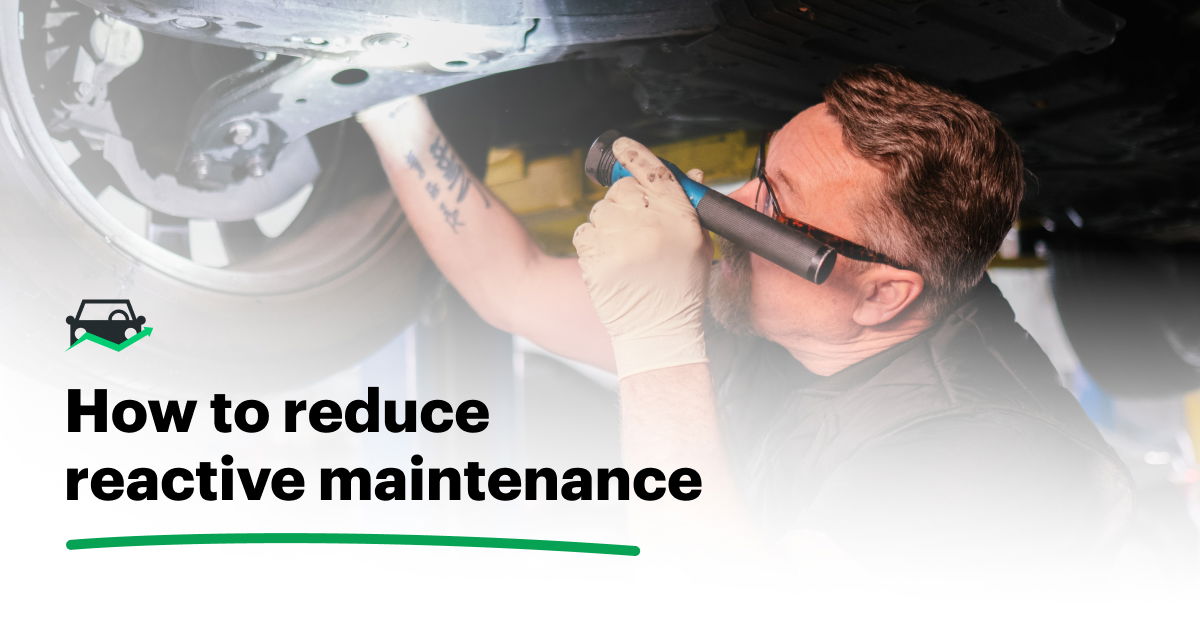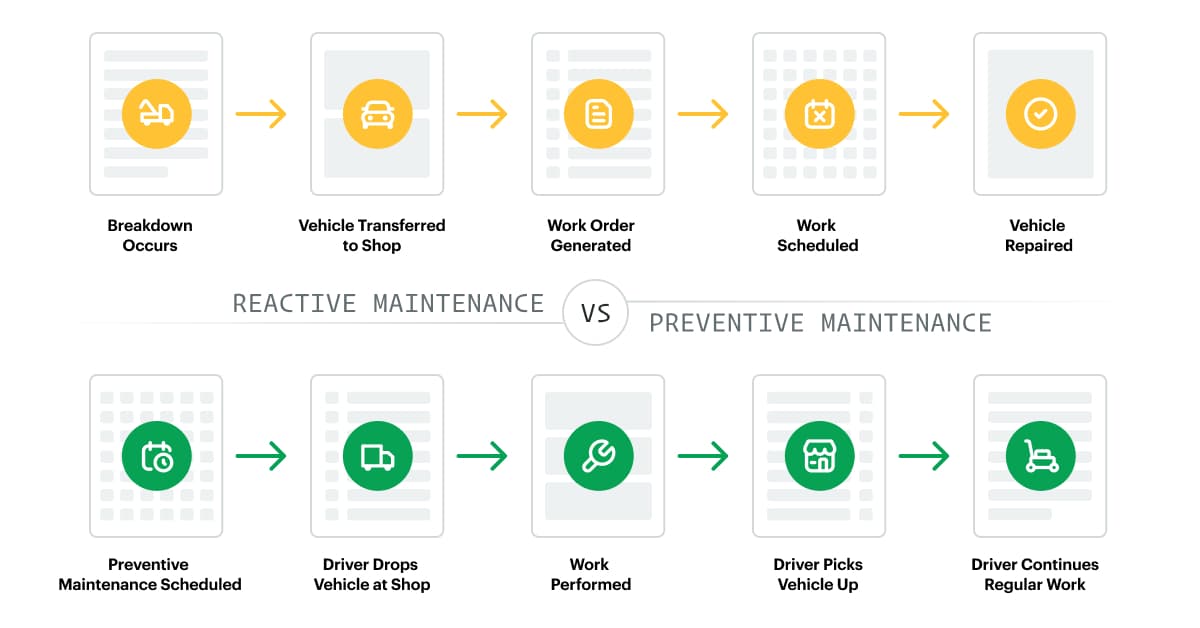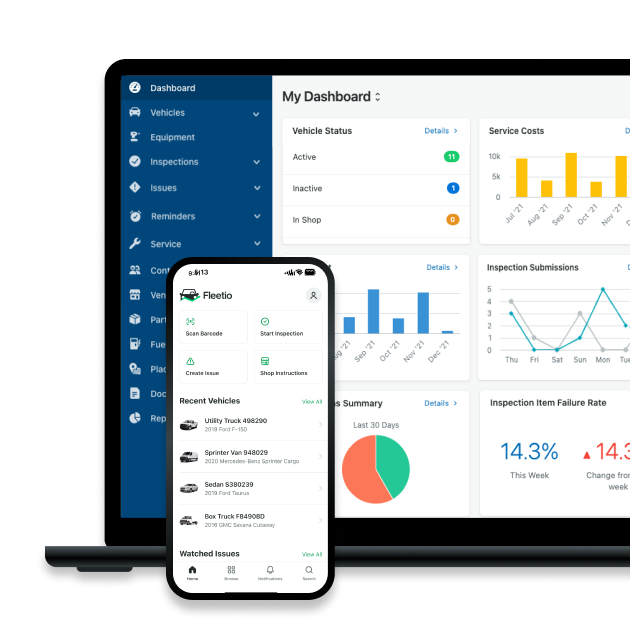Using fleet management software to track reactive maintenance histories can help you build stronger preventive maintenance schedules for your fleet.

What is Reactive Maintenance?
Reactive maintenance refers to the act of repairing an asset after it has broken down and restoring it to safe, operable condition. Reactive maintenance can take a toll on fleet assets, decreasing their overall useful life due to increased component wear and tear and breakage. Additionally, reactive maintenance is associated with higher service spend and increased downtime. While some fleets still rely heavily on reactive maintenance, more fleets are switching to preventive and proactive maintenance tactics to increase productivity, profitability and ROI.
Corrective and Reactive Maintenance
In our Fleet Unscheduled Maintenance Best Practices blog, we categorized corrective and reactive maintenance as unplanned maintenance severity levels—but we wanted to dive deeper into the two respectively. While corrective maintenance is a type of reactive maintenance, and the two are often used interchangeably, corrective maintenance differs in that:
-
It is a soon-to-be-repair if not addressed
-
It is a soon-to-be-repair caught during a time of unplanned maintenance for that specific item. For example:
-
A vehicle is in the shop for a tire rotation. The tech notices one tire has a bulge and starts the process of adding a tire replacement to the work order. Although scheduled maintenance may have been taking place, the tire replacement was unplanned, yet the potential issue was corrected before it became a repair.
-
Alternatively, perhaps the vehicle was not being serviced, but its driver noticed the tire bulge during the pre-trip inspection and started the process of submitting a work order to bring the vehicle into the shop, again solving the problem before it became a repair.
-
With these examples, you can see how the corrective maintenance type of reactive maintenance is both reactionary (in that the action takes place in response to a perceived problem) and that it’s still very much maintenance (in that there is nothing yet to be fixed, just a potential problem to be corrected).
Reactive maintenance of the non-corrective type, however, is a repair. So, in both the previous examples, the tire issue was never spotted and, eventually, the vehicle got a flat and had to be towed to the shop. While the tire is replaced no matter which example is used, a road blowout increases the likelihood of additional and costly vehicle damage. In short, reactive maintenance leads to increased costs through delayed downtime—whether that’s waiting on parts, labor or outsourced maintenance—additional vehicle damage and possibly roadside assistance.
Stay prepared for the year ahead with Fleetio
Give Fleetio a try for freeReplacing Reactive Maintenance with Preventive Maintenance
To completely rid yourself of reactive maintenance would be impossible, but there are ways to reduce the chances. One way is through vehicle inspections. Adding spot checks to items prone to maintenance needs or failure can help you catch issues early. Additionally, adding specific instructions for drivers on inspection tasks allow them to keep an eye out for problems they otherwise wouldn’t know to look for.
Another way to reduce reactive maintenance is by strengthening equipment maintenance procedures. Unlike reactive (and corrective) maintenance, PM helps fleets keep assets in top condition using proactive, interval-based scheduled downtime to assess asset health and address high wear and tear components. Fleets can even customize maintenance schedules based on asset age, mileage/meter, asset type and other criteria specific to the asset. Similar to inspections, adding fail-prone and high-maintenance items as points of inspection during regular PM schedules can help you catch when those items need maintenance versus repair. Proper PM not only improves an asset’s useful life, it helps curb service spend and downtime.

Reactive vs Preventive Maintenance
Benefits of Tracking Corrective/Reactive Maintenance Histories
By tracking corrective/reactive maintenance histories, you can determine patterns in high-maintenance and high fail items across your fleet which aren’t currently on PM schedules. You may notice a certain brand of brakes aren’t holding up on heavy-duty assets or that vehicles in extreme heat climates are experiencing higher battery terminal corrosion that needs to be cleaned more frequently to avoid replacement. A comprehensive fleet management software with a maintenance log app makes fleet reporting and analyzing this data quick and easy, so you can add these types of issues to PM schedules and/or daily inspections as applicable.
By using customizable labels in Fleetio, you can categorize vehicles’ service histories. For example: If you label all your corrective maintenance issues as "CM" (or your label of choice), you’ll be able to see which vehicles have been serviced under that label and with what parts when you pull your fleet’s service history report and filter by that label, allowing you to see any repeating failures. From that data, you can build stronger inspections and PM schedules and correct any parts issues – improving your truck fleet maintenance management process.
Find out how Fleetio can help you streamline your fleet maintenance needs. Start your free trial or request a demo of Fleetio today!

